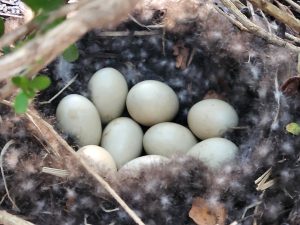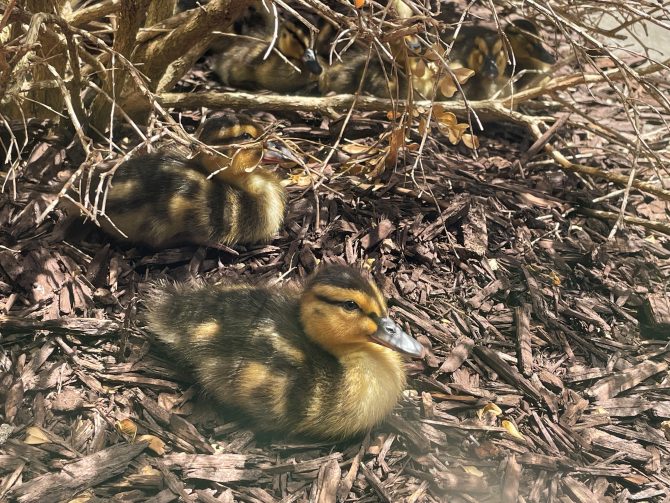Every year since 2012, we have welcomed feathered friends to the courtyard in the Children's Library. The ducks find it a safe refuge for raising their babies, and library staff and patrons enjoy seeing them. We have gathered some facts about Mallard ducks below and an FAQ to help you learn everything we know about our migrating visitors.
Here are some pictures from 2012.



Mallard Duck Facts
Common Name: Mallard Duck
Scientific Name: Anas platyrhynchos
Life Span: 5-10 years
Size: 20-26 inches
Weight: 2-3 pounds
Diet: Omnivore
Mallards can be found on nearly every continent. This map from National Geographic shows their wide range of habitation.
Only the female Mallard duck (called a hen) makes the familiar “quack” sound that we associate with ducks. The male Mallard (called a drake) is the one with the beautiful green head.
Mallards can fly fast. Migrating flocks of Mallards have been estimated to travel at 55 miles per hour.
Frequently Asked Questions
Why are they there? Does CPL put the ducks in the courtyard?
No. The ducks decide to build nests and lay eggs on their own.
If you are interested in raising your own flock, read up to see what animals are allowed in your neighborhood, as there are various ordinances on keeping fowl (a fancy word for birds like ducks, geese, chickens, and more). Once you know what you can welcome to your backyard, we can help you locate resources related to the breeds you are considering. We suggest you check the rules and ordinances specific to your location so you do not run afoul of them.

How many eggs/babies are there?
A typical clutch is about 13 eggs. We have seen above and below this number in past years. The number can change day-to-day depending on Mother Nature. Ask staff on-site for our current estimates, and we will share what we know. In years past, we have had two to four different nests in the courtyard.


Where else do they lay eggs?
Look around the library to see if you can find more nests. This photo is of a nest near the fireplace area in 2018. Please make sure to be kind to any animals you see so as not to disturb them.

Where is the male bird/father?
Though the ducks pair up through winter, once spring sets in and they mate, the male Mallard (called a drake) only stays with the female (called a hen) until the eggs have been laid. After that, he may attempt another mating. Some hens have ducklings belonging to multiple drakes in the same clutch or group of eggs. Only the hen incubates the eggs and takes care of the ducklings.

How long until they hatch?
Ducklings hatch after 28 days and are born precocial, meaning they can walk, swim and feed themselves right after birth.
In the wild, the hen leads the young to the water and leaves the nest for good. Ducklings stay with the hen until they can fly at roughly two months old. As we have no natural pond in the courtyard, we put out various containers for them to learn to swim and drink. Ask library staff about when we first noticed the nest and see if you can figure out when they will hatch.


Who feeds the ducks?
Staff members take turns volunteering to ensure the ducks have food, which is usually done by our excellent Business Services staff.
What do you feed the ducks?
Since the courtyard could be more biodiverse, we supplement by feeding the ducks a duck pellet that is commercially sold and recommended for growing ducks. It includes a variety of ingredients, including corn, wheat, fish meal, vitamins, folic acid and many prebiotics and probiotics.
Where do they go once they get too big for the courtyard?
Once the ducklings outgrow the courtyard, a small group of our staff volunteers round them up and safely transport them to one of the ponds near the library. Last year, we released them into the pond at the center of Heritage Park.


When will they fly?
Baby Mallards will remain flightless for the first 60 days of their life. This is another reason we must relocate them to the pond, so they can learn how to be proper ducks.



Add a comment to: Ducks Amuck